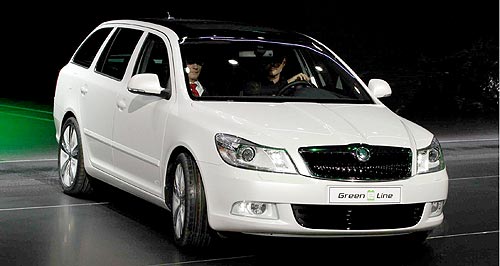Make / Model Search
Future models - Skoda - Octavia - Green E LineParis show: Skoda electrifies OctaviaGoing the distance: Skoda claims that its Octavia-based EV can travel 140km between charges. Octavia-based Green E Line wagon emerges as Skoda’s first electric vehicle1 Oct 2010 By TERRY MARTIN VOLKSWAGEN has applied electric vehicle technology to its Skoda brand, enabling the Czech division to unveil its first EV at the Paris motor show this week in the form of the Octavia Green E Line. Although described as a concept, Skoda has made it clear that the Green E Line – which is based on the Octavia Combi station wagon – is a “series-production car” and that it plans fleet trials in 2011. The company claims that the Octavia’s modular floor unit made it the “ideal option” in terms of arranging the batteries, electronic control units and the electric motor.  Left: Skoda Auto chairman Winfried Vahland. Below: Skoda Octavia Green E Line. Left: Skoda Auto chairman Winfried Vahland. Below: Skoda Octavia Green E Line.Drawing from a 26.5kW 325-volt lithium-ion battery pack, the synchronous electric motor is said to offer constant power of 60kW and a maximum 85kW (for 60 seconds), with torque peaking at 270Nm (for four seconds, or 255Nm for 60 seconds). The result, according to Skoda, is “sharp acceleration and a good amount of agility and responsiveness” for the 1611kg vehicle, with 0-100km/h acceleration in 12.0 seconds and a maximum speed of 135km/h (limited). The driving range is claimed to be 140km before recharging will be required, a distance that Skoda says “comfortably meets the requirements of most everyday commuters in Europe”. The quoted recharging times range from four hours with a 400-volt connection to around eight hours with a domestic 230-volt supply. The recharging cable connections are in the hollow of the grille (behind the Skoda badge, which can be lifted off) and under the existing fuel cap. Weighing 315kg and comprising 180 lithium-ion cells (each measuring 150mm in diameter and 650mm long), the battery pack is under the the floor and extends partly into the luggage compartment, although the manufacturer insists that it has almost no impact on luggage volume and that the five-seat passenger compartment is unchanged compared with the regular Octavia wagon. Luggage capacity is 490 litres, extending to 1540 litres with the rear seats folded down. By comparison, the regular Octavia Combi offers 580 litres and 1620 litres respectively. A dash-mounted screen relays relevant information to the driver such as instant output, power consumption, battery charge and the remaining charge, while the navigation display unit has graphics that describe the energy flow – that is, whether the electric engine is being supplied with, or is generating, electricity. The standard interior lights have also been replaced by energy-saving LEDs. The ultra-green Octavia’s exterior is finished in pearl-white – a colour that is meant to convey the environmental-friendliness and “purity” of its electric propulsion – and has chrome trim at the front and rear, while a contrasting high-gloss black roof features integrated energy-generating photovoltaic panels. Most other aspects mirror the conventional-engined Octavia, such as the McPherson strut front and multi-link rear suspension and electro-mechanical power steering system. The EV also runs on 7.5x18-inch wheels with 225/40 R18 tyres. Skoda Auto chairman Winfried Vahland said the Octavia Green E Line “embodies the values of the brand absolutely perfectly”. “The vehicle combines the desire for individual mobility with our environmental goals,” he said. There is no word yet on global production of the vehicle, but with a redesigned Octavia expected in 2013, the EV is likely to materialise in final mass-production form in the next generation. The company, which is heavily reliant on offering high value for money with its vehicles (with EVs being no exception), says solutions will be designed within the VW Group’s joint development program “to push down the cost of batteries to a level that will make them even more affordable for customers”. Skoda also announced this week that its GreenLine package – which is akin to Volkswagen’s BlueMotion, with measures such as engine idle-stop, brake energy recuperation and low-rolling-resistance tyres – had entered its “second generation” on the Yeti compact SUV and Roomster mini-MPV, handing them the lowest emissions levels in their respective categories. With a 77kW 1.6 TDI engine, the Yeti GreenLine can return fuel economy of 4.6L/100km and 119g/km of CO2, while the Roomster GreenLine is an even darker shade of green with its 55kW 1.2 TDI that manages 4.2L/100km and 109g/km. Other GreenLine models available in Europe are the Octavia and Superb (with the 1.6 TDI) and the Fabia (with the 1.2 TDI). Although Volkswagen Australia now has the green light to introduce BlueMotion vehicles Down Under, the company has confirmed that it has no intention of offering GreenLine Skoda variants in the short-term.  Read moreAll future modelsOctavia pricing
Motor industry news |
Click to shareSkoda modelsResearch Skoda All future modelsOctavia pricing
Motor industry news |


 Alfa Romeo
Alfa Romeo Abarth
Abarth Audi
Audi Aston Martin
Aston Martin BMW
BMW Bentley
Bentley Ferrari
Ferrari Chevrolet
Chevrolet Ford
Ford Fiat
Fiat GWM
GWM Foton
Foton Hyundai
Hyundai Honda
Honda Jaguar
Jaguar Isuzu
Isuzu Kia
Kia Jeep
Jeep Land Rover
Land Rover Lamborghini
Lamborghini Maserati
Maserati Lexus
Lexus McLaren
McLaren Mazda
Mazda Mercedes-Benz
Mercedes-Benz Mitsubishi
Mitsubishi Mini
Mini Peugeot
Peugeot Nissan
Nissan Ram
Ram Porsche
Porsche Rolls-Royce
Rolls-Royce Smart
Smart Skoda
Skoda Suzuki
Suzuki Subaru
Subaru Toyota
Toyota Tesla
Tesla Volvo
Volvo Zeekr
Zeekr







Facebook Twitter Instagram